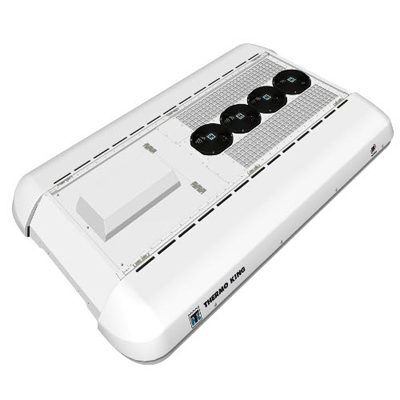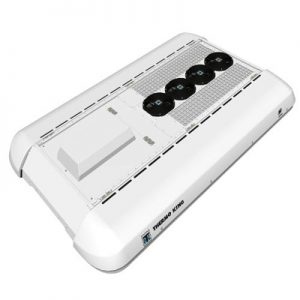

Miami-Dade and Gardenia demonstrate Thermo King HVAC alternatives
By David Hubbard
All-electric heating, ventilation and air conditioning (HVAC) for hybrid buses and trolley buses is not new. However, supplying high voltage power to the electric HVAC unit using an independently powered alternator driven by the bus engine is.
The primary obstacle when the alternator or generator drives the bus engine is maintaining clean, stable voltage throughout the speed range of the engine. In this application developed in 2004, the alternator provides a high voltage output to a static converter that conditions and stabilizes the voltage before powering the electric compressors and fan motors.
“Creating electric power from an alternator or generator is not a new concept, but creating it to power something as large and complex as a bus HVAC system is,” says Steve Johnson, senior product manager for Thermo King, a manufacturer of transport temperature control systems for a variety of mobile applications and a brand of Ingersoll Rand. “You must deal with the changing speed of the engine and its variable output.”
The HVAC system is the largest electrical load on a transit bus, requiring as much as 40 percent of the total available electrical energy. Essentially, the HVAC can now operate separately from the engine as it is no longer linked to engine revolutions per minute. This constant energy flow creates new opportunities to optimize the performance of the HVAC system.
“The trick in making it work most effectively is the intelligence of the inverter system,” says Johnson. “This little black box allows the varying input of DC voltage coming in from the alternator to converge into a constant output.”
The alternator output is variable with engine speed. The variable output adjusts to provide a constant output to the HVAC system regardless of engine speed, and can provide full capacity at engine idle.
Thermo King cites the benefits to this technology as lower maintenance costs, improved reliability, fuel savings and a control system that optimizes energy management and conservation.
Alternator power can be applied to rear mount and roof mount all-electric HVAC systems that feature environmentally sensitive, high-efficiency hermetic scroll compressor technology inside the unit.
The alternator powered all-electric HVAC system from Thermo King can be used on all diesel engine driven transit buses and motorcoach markets. It can also be used in hybrid bus applications when the available power for an all-electric HVAC system is limited. Flexible hoses that would connect with the compressor to the unit have been eliminated and replaced with robust wiring, which should significantly reduce the level of maintenance required over the life of the bus.
The HVAC system comes factory pre-charged with high-capacity refrigerant R-407C. It also features a one-piece design for easy installation. All pipes and fittings are enclosed within the system to help ensure refrigerant remains contained.
The one-piece all-electric Athenia E-800 from Thermo King is a hermetically sealed rooftop unit for hybrid bus, trolley bus and alternator-powered applications.
Miami-Dade Transit electrifies
Miami-Dade Transit (MDT), Miami, FL, the nation’s 14th largest public transit system, is one of the nation’s first transit agencies to electrify bus accessories. In a move to improve energy efficiency and reduce operational costs, it recently electrified key accessories on 13 NABI 40 foot diesel/electric hybrid buses and five 40 foot Gillig diesel/electric hybrids, which officials expect will prove 25 percent more fuel efficient.
“By electrifying accessories on MDT buses, we are saving money and operating our buses more efficiently,” said Harpal S. Kapoor, former director of MDT. “This also reflects our long-term commitment to increasing sustainability for our community.”
The electrified accessories include the propulsion system; the radiator fans; and the heating, ventilation and air conditioning system. Electric power steering will be added when the manufacturer makes it available.
Miami-Dade Transit initiated the electrification process on a trial bus in early 2010. When the pilot proved successful the agency electrified eight buses and put its last five into service in April 2011. Based on the anticipated savings, the county says it expects to recoup its investment by 2015.
As part of its effort to implement environmentally conscious initiatives, MDT has committed to purchasing only hybrid buses. Over the next five years the agency says it plans to electrify other bus components such as power steering, doors, air compressors and wheelchair ramps.
Oahu Transit, Honolulu, HI, has taken delivery of 10 buses with all-electric HVAV with 48 more buses currently being delivered. Culver City, CA, is running 22 buses, and Antelope Valley, CA, is running 13 units with 17 more on order.
Gardena Municipal Bus Lines
The new Gardena Municipal Bus Lines (GMBL), Gardena, CA, is one of the nation’s only transit systems to feature 100 percent electric heating, ventilation and air conditioning systems on its hybrid buses. However, it relies on the all-electric HVAC technology Thermo King developed in 1994. This technology has increased fuel efficiency on its 53 hybrid buses by an estimated 8 percent and lowered operating costs while providing 13,500 consistently comfortable rides on an average weekday.
The City of Gardena selected and installed the all-electric HVAC systems in 2010 to reflect a city-wide commitment to increased sustainability, greater reliability and reduced energy and repair costs, and to adhere to forthcoming California Air Resource Board regulations.
“Beyond the cost savings and the sustainability benefits, the consistent reliability of the electrified HVAC systems has been a huge benefit for the agency,” said Tony Cohen, equipment maintenance superintendent for GMBL. “The hybrid buses are so dependable that we’ve seen most repair costs and passenger complaints become a thing of the past.”
Because energy needs to come from somewhere to power an all-electric HVAC system, Thermo King has applied this technology first to electric rail cars, trolley buses and most recently to hybrid-electric transit buses.
Other municipal transit fleets to utilize this HVAC technology include Hamilton, ON, Canada; Victoria, BC, Canada; Chicago Transit Authority, Chicago, IL, and Long Beach, CA.
Typically, the HVAC on a 40-foot bus is capable of putting out 110,000 BTUs at high engine speeds, even though the capacity required to cool and maintain a passenger filled bus is actually somewhere between 60,000 – 70,000 BTUs.
The tendency has been to design oversized HVAC systems to compensate for performance specifications and variable capacity due to variable engine speeds. All-electric HVAC with its constant output is not affected by varying engine speed.
All this leads bus operators to reconsider ways the industry measures performance of buses in terms of pull-down requirements. With new technology the standards will evolve accordingly. BR
